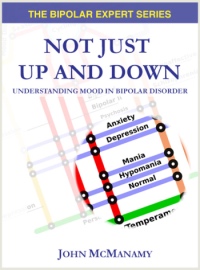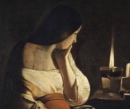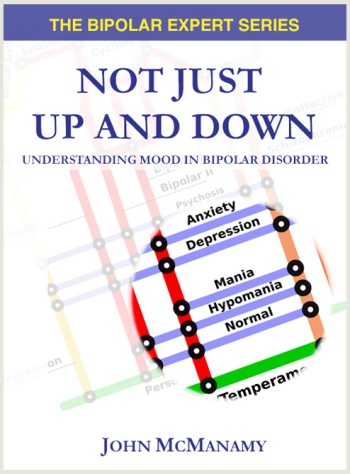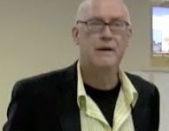The Mood Spectrum
 |
Now that you're familiar with the DSM forget everything you've read.
|
Mood Spectrum. Contemplate this: “detecting bipolar depression in its pleomorphic expressions.”
If you think you read the above in “The Da Vinci Code” you are readily forgiven. It is part of the title of an article by Hagop Akiskal MD of the University of California at San Diego that introduces a special edition of the Journal of Affective Disorders. The February 2005 Journal is entirely given over to the mood spectrum from a bipolar depression perspective, with Dr Akiskal as the guest editor. Dr Akiskal is best known for advocating that the criteria for bipolar disorder be widened to include as many as half of those currently diagnosed with unipolar depression.
My New Book!

Purchase now.
The Mood Spectrum Puzzle
Essentially, many people with so-called unipolar depression have much in common with those with bipolar disorder. But before we toss out our current DSM, it appears that unipolars and bipolars tend to manifest rather different, though not readily distinguishable, depressions. Talk about pleomorphic. Welcome to the DSM-VI(nici) Code, where riddles rule and paradox is the name of the game. But the beauty of the puzzle is that the clues are surprisingly obvious and simple, once we learn where to look.
The obvious starting point is unipolar depression. But even in unipolar depression life is not exactly uni, as Massimo Biondi MD and his colleagues at the University of Rome explain. In a study, he and his co-authors examined two different groups of meds-free depressed patients using two different screening tools. They concluded that depression is characterized by three dimensions: pure depressive, pure anxious, and pure activation, corresponding to three basic emotions – sadness, fear, and anger.
If you expect to find DSM support for this, forget it (with fine print exceptions), unless you happen to be looking under borderline personality disorder. That is the argument Dr Akiskal and Franco Benazzi MD of the Hecker Outpatient Psychiatry Center (Ravenna) make in another article. Where the DSM does acknowledge anger is on the other side of the diagnostic divide as a criteria for hypomania (“persistently elevated, expansive, or irritable mood”). Akiskal and Benazzi, however, tell a far different story. The two interviewed 602 meds free patients diagnosed with either unipolar depression or bipolar II depression, and found 37.4 percent in the unipolar group and 59.7 percent in the bipolar II group displayed irritability (which involves anger).
Now it gets interesting. In the unipolar depression group, the authors found that 66.3 percent of those who were irritable had at least three hypomanic symptoms – what the authors call a depressive mixed state – vs just 13.8 percent among those who were not irritable. Among those with bipolar depression, the differences were similar, 80.2 percent to 35.7 percent.
In another study reported in a later issue of the same journal, the two authors found that agitated depression was present in 19.7 percent of a sample of 254 depressed patients. Concluded the authors: "Agitated depression emerges as a distinct affective syndrome with weight loss, pressure of speech, racing thoughts and suicidal ideation." The authors also found non-euphoric hypomania and evidence of mixed states. Accordingly they suggested that agitated depression be regarded as "pseudo-unipolar" and indicated their preference for the terminology of the pioneering Kraepelin of "excited (mixed) depression."
So what do we do with these irritable and depressed people with or without mixed states that the DSM presently ignores? Keep them as unipolars? Only if you want them to keep failing in their treatments. As Dr Akiskal says in his introductory article, “the nonrecognition of depressive mixed state is nothing short of a clinical tragedy because these are the very ‘unipolar’ depressive patients who are likely to do poorly on antidepressants …”
How about admitting them to the bipolar club, then? That would at least get clinicians thinking about treating these people with mood stabilizers.
Maybe we could give them a diagnosis of their own. As the authors point out: “Major depressive disorder with irritability may lie along a continuum linking bipolar II and nonirritable major depressive disorder.”
The point is labels and classifications hardly matter, so long as they give us a reasonably accurate representation of clinical reality. There is a strong case to be made that the DSM-IV completely fails large numbers of us in this regard and so probably will the DSM-V. We have yet to crack the DSM-VI(nci) Code, but we have many promising leads, more than enough to give clinicians something to work with in the here and now. Is your psychiatrist up to speed?
Atypically Depressed
Drs Akiskal and Benazzi also examined the same group of patients for symptoms of “atypical” depression. As opposed to melancholic depression, atypical depression is characterized by mood reactivity plus at least two of the following symptoms: increased weight, increased eating, increased sleep, leaden paralysis, and interpersonal sensitivity. Past studies have shown that atypical depression is far more common in bipolar II than unipolar depression, a finding confirmed by this one (71 percent vs 30 percent).
In this study, 65 percent of those with atypical depression experienced depressive mixed states and 45.5 percent had a family history of bipolar disorder (vs 38.7 percent and 24.1 percent, respectively, for those without atypical depression). Even in the unipolar group, those with atypical depression had twice the family history of bipolar disorder than those without atypical depression (24 percent vs 12.8 percent), plus a lower age of first onset (25.8 years vs 34.4 years), leading the authors to suggest yet another bridge “in a spectrum subsuming bipolar II and unipolar disorders.”
The Mood Spectrum – Some Background
Depression and bipolar disorder are classified as separate illnesses, but psychiatry is increasingly viewing them as part of an overlapping spectrum that also includes anxiety and psychosis.
The Spectrum Project is an international consortium of academic researchers led by Giovanni Cassano MD of the University of Pisa. In 2004, this writer sat down with one of Dr Cassano’s collaborators on the project, Ellen Frank PhD of the University of Pittsburgh. Said Dr Frank: "What we’ve been arguing is that even isolated symptoms that don’t cluster together to create episodes may be important."
A 2004 study by the Spectrum collaborators found that, among other things, even one hypomanic symptom in a unipolar depressed individual can have significant repercussions. Here, each manic/hypomanic item increased the likelihood of suicidal ideation by 4.2 percent. For 10 items (the researchers used a much longer checklist than the one appearing in the DSM), this would equate to a 42 percent increased risk.
Then there is Dr Akiskal. In a 2003 study with his university colleague Lewis Judd MD, Dr Akiskal re-examined data from the landmark Epidemiological Catchment Area study from two decades ago. The original study found that .08 percent of the population surveyed had experienced a lifetime manic episode (the diagnostic threshold for bipolar I) and .05 a hypomanic episode (the diagnostic threshold for bipolar II). But by tabulating survey responses to include criteria below the diagnostic radar, such as one or two symptoms over a short time period, the authors of the study recalculated the data to arrive at an additional 5.1 percent of the population, adding up to a total of 6.4 percent of the entire population who could conceivably be thought of as having bipolar disorder.
Dr Akiskal has also been working with Elie Hantouche MD of the Pitie-Salpetriere Hospital (Paris) and Jean-François Allilaire MD of the University of Paris comparing depression in unipolar and bipolar populations. His current studies in the Journal of Affective Disorders special issue build on that earlier research.
Raymond DePaulo MD of Johns Hopkins tackles the mood spectrum from a genetic viewpoint. His Johns Hopkins team is slicing and dicing their study populations into various family subgroups in order to try to tease out elusive genes. Thus, the broader the spectrum the more diverse the patients, who tend to pass on their particular spectrum traits to their offspring.
Others in the field include Athanasios Koukopoulos MD of the University of Rome who has considerably added to our understanding of agitated depression; Jules Angst of Zurich University who has identified patients with “softer” bipolar symptoms in a large local cohort, Robert Hirschfeld MD of the University of Texas, Galveston, whose Mood Disorders Questionnaire is far more sensitive than standard instruments in spotting bipolar disorder, and S Nassir Ghaemi MD of Harvard who has proposed a separate “bipolar spectrum disorder” diagnosis occupying the middle ground between unipolar and bipolar.
To fully appreciate the dynamic of the mood spectrum we need to cast our minds back to the 1976 when Frederick Goodwin MD and his colleagues in a seminal article first proposed bipolar II. The DSM finally caught up to Dr Goodwin in 1994. Thus, when it comes to talking about widening old diagnostic categories or creating new ones, we have a strong precedent as well as a sobering case study on why patients and clinicians should not regard the DSM as Holy Writ.
Although Dr Frank cautioned in our interview, "I don’t think we know yet whether [our findings have] treatment implications,” and that “this is a new area of research, relatively speaking, and we don’t know exactly where it will lead us," she also advised:
“I think patients need to be aware of what might be softer expressions of both hypomania or mania, and try to the fullest extent possible to get their doctors to listen to their concerns that there may be something more going on here than unipolar depression.”
Bipolar Waiting to Happen?
Is unipolar depression simply bipolar I or II waiting to happen? There is strong evidence that east is east and west is west, but we are also discovering that more than occasionally the twain shall meet. In a study published in the special issue of the Journal of Affective Disorders, Dr Angst and his colleagues at Zurich University tracked 406 patients with major mood disorders over a 20-year period. Of 309 patients presenting with depression, 121 (39.2 percent) eventually manifested as bipolar (24.3 percent to bipolar I, 14.9 percent to bipolar II). In all, more than 50 percent of the study population turned out to have bipolar disorder.
Part of the phenomenon may be due to unrecognized bipolar in the first place. The authors of the study referred to a 1999 study by Dr Ghaemi that found a 7.5-year period between the onset of depression and a diagnosis of bipolar and a 1993 survey by the Depression and Bipolar Support Alliance that found an eight-year wait.
Getting the Right Diagnosis
Eight years is an eternity when it comes to getting the correct diagnosis, much less the appropriate treatment. Fortunately, reading between the lines of the DSM-VI(nci) Code can speed up the process. One means is to closely probe individual depressions for “unipolar” or “bipolar” characteristics. In a study of separate unipolar and bipolar populations comprising 493 patients, Drs Akiskal and Hantouche teased out a number of distinguishing features, namely:
Those with bipolar II depression experienced greater suicidal thinking, guilt, depersonalization, and derealization. Despite hypersomnia and weight gain, they experienced more psychomotor activation, suggesting a mixed depressive state.
Patients with unipolar depression, on the other hand, had more psychic anxiety and insomnia and rated higher on slow thinking, lack of energy, feeling worst, avoiding risks, life dull, and dreary. Psychomotor retardation was highest among those in this group.
Behavioral Clues
Needless to say, the above distinctions may entirely elude many clinicians. Accordingly, in another article, Dr Akiskal proposes the following behavioral characteristics, based on his own clinical experience:
- Proficiency in three or more languages (which is rare amongst people in the US but may not apply in Europe)
- Working in fields that require personal charm and eloquence such as diplomacy, journalism, and entertainment; creativity (especially those who excel in three or more domains)
- Instability in life (such as going to three universities without getting a degree or changing professions from one to another to yet another)
- Activity junkies (such as individuals who travel long distances more than three times a month)
- Substance use (especially three or more drugs); co-occurring illnesses (such as those with at least three anxiety disorders)
- Multiple outrageous behaviors (including borderline personality, compulsive gambling, sexual addiction, and taking extreme risks); sexual excesses;
- Flamboyance (such as pink socks in a male patient).
The frequency of the number three is no accident. Dr Akiskal refers to the phenomenon as “the rule of three.”
Dr Akiskal does not suggest slapping a bipolar label on every engaging and creative individual who just happens to look stunning in Versace, but he does urge that clinicians be mindful of the warning signs and carefully screen these patients for bipolar.
Bewitched, Bothered, and Bewildered
Most people presenting with severe depression are not about to be mistaken for the type who dance on tables, Versace or no Versace. Accordingly, Dr Akiskal recommends a follow-up screening soon after the patient shows improvement, when he or she is in a better position to recall what is was like to feel a little too good.
But the first visit nonetheless provides the opportunity for clinicians to probe for mixed states and agitation. Dr Akiskal cites a 2000 study by Dr Benazzi that found that irritability, distractibility, and racing thoughts were the most common hypomanic features during depression, especially among depressed individuals with bipolar II. A study by Alessandro Serretti MD and Paolo Olgiati MD of Vita-Salute University (Milan) in the Journal special issue largely corroborates this finding. Agitated activity was the most frequent manic symptom amongst the unipolar patients in the study, followed by irritable mood, distractibility, reduced need for sleep, and reckless activity.
Ironically, mixed and angry and agitated depressions can appear so far out of the ordinary that clinicians often look outside the mood spectrum. As Akiskal and Hantouche point out:
“Bipolar depression is, by its very nature, more unstable and intense, and therefore misleading in everyday clinical practice. Many patients presenting bipolar II depression would be considered as ‘histrionic’ or other personality disorder and the authenticity of depression would often appear questionable to the external observer.”
Closing Arguments
Dr Akiskal would open Dr Goodwin's bipolar II door to include virtually half the population currently classified with unipolar depression and a good many with personality disorders. But the catch is the doors marked bipolar I or bipolar II are the ones most of us recall being dragged kicking and screaming though. And we were the more obvious cases. At least in a rational moment, the logic of the diagnosis began to sink in once we reflected on all those swinging high times we enjoyed or those raging moments that had the neighbors calling 911. But these candidates? Their walk on the wild side may have been coupon night at the Olive Garden.
At some point, however, desperation sets in, especially after all treatments have failed. The only hope now may be a new diagnosis, even one that carries one of the world’s most notorious stigmas. In the special issue, Akiskal and Hantouche et al report that one-third of treatment-resistant depressed patients responded to mood stabilizer augmentation.
Call me crazy, just hand me that prescription. Wrote journalist and patient Vanessa Grigoriadis in New York Magazine:
As much as depression was the illness of nineties, mild bipolarity has become the new diagnosis for a slice of society that includes hard-to-treat depressives and some with a personal disposition that perhaps hedges into ordinary moodiness.
What has been driving the trend is Lamictal’s 2003 FDA indication for maintenance treatment of bipolar I. Despite the fact that the FDA said nothing about bipolar II and only refers to depression in the fine print, the indication has been interpreted as an open door to treat depression in bipolar II populations. In 2004, the drug earned $1 billion in sales worldwide, a rise of 32 percent over the previous year. In the US, sales went up 49 percent, which the manufacturer GSK attributed to the FDA indication.
Could Lamictal wind up doing for bipolar what Prozac did for depression? The thought is simultaneously encouraging and frightening.
April 8, 2005, reviewed Jan 5, 2011
 |
More articles on mood. |




